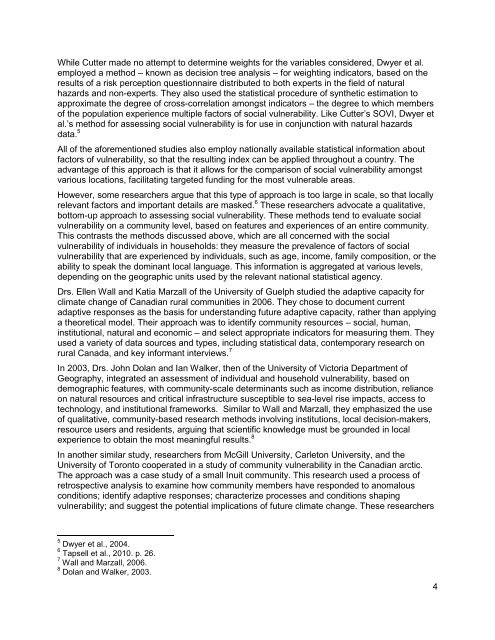Lunenburg Part 2 - Section 5 - Social Vulnerability - August 30.pdf
Lunenburg Part 2 - Section 5 - Social Vulnerability - August 30.pdf
Lunenburg Part 2 - Section 5 - Social Vulnerability - August 30.pdf
You also want an ePaper? Increase the reach of your titles
YUMPU automatically turns print PDFs into web optimized ePapers that Google loves.
While Cutter made no attempt to determine weights for the variables considered, Dwyer et al.<br />
employed a method – known as decision tree analysis – for weighting indicators, based on the<br />
results of a risk perception questionnaire distributed to both experts in the field of natural<br />
hazards and non-experts. They also used the statistical procedure of synthetic estimation to<br />
approximate the degree of cross-correlation amongst indicators – the degree to which members<br />
of the population experience multiple factors of social vulnerability. Like Cutter’s SOVI, Dwyer et<br />
al.’s method for assessing social vulnerability is for use in conjunction with natural hazards<br />
data. 5<br />
All of the aforementioned studies also employ nationally available statistical information about<br />
factors of vulnerability, so that the resulting index can be applied throughout a country. The<br />
advantage of this approach is that it allows for the comparison of social vulnerability amongst<br />
various locations, facilitating targeted funding for the most vulnerable areas.<br />
However, some researchers argue that this type of approach is too large in scale, so that locally<br />
relevant factors and important details are masked. 6 These researchers advocate a qualitative,<br />
bottom-up approach to assessing social vulnerability. These methods tend to evaluate social<br />
vulnerability on a community level, based on features and experiences of an entire community.<br />
This contrasts the methods discussed above, which are all concerned with the social<br />
vulnerability of individuals in households: they measure the prevalence of factors of social<br />
vulnerability that are experienced by individuals, such as age, income, family composition, or the<br />
ability to speak the dominant local language. This information is aggregated at various levels,<br />
depending on the geographic units used by the relevant national statistical agency.<br />
Drs. Ellen Wall and Katia Marzall of the University of Guelph studied the adaptive capacity for<br />
climate change of Canadian rural communities in 2006. They chose to document current<br />
adaptive responses as the basis for understanding future adaptive capacity, rather than applying<br />
a theoretical model. Their approach was to identify community resources – social, human,<br />
institutional, natural and economic – and select appropriate indicators for measuring them. They<br />
used a variety of data sources and types, including statistical data, contemporary research on<br />
rural Canada, and key informant interviews. 7<br />
In 2003, Drs. John Dolan and Ian Walker, then of the University of Victoria Department of<br />
Geography, integrated an assessment of individual and household vulnerability, based on<br />
demographic features, with community-scale determinants such as income distribution, reliance<br />
on natural resources and critical infrastructure susceptible to sea-level rise impacts, access to<br />
technology, and institutional frameworks. Similar to Wall and Marzall, they emphasized the use<br />
of qualitative, community-based research methods involving institutions, local decision-makers,<br />
resource users and residents, arguing that scientific knowledge must be grounded in local<br />
experience to obtain the most meaningful results. 8<br />
In another similar study, researchers from McGill University, Carleton University, and the<br />
University of Toronto cooperated in a study of community vulnerability in the Canadian arctic.<br />
The approach was a case study of a small Inuit community. This research used a process of<br />
retrospective analysis to examine how community members have responded to anomalous<br />
conditions; identify adaptive responses; characterize processes and conditions shaping<br />
vulnerability; and suggest the potential implications of future climate change. These researchers<br />
5 Dwyer et al., 2004.<br />
6 Tapsell et al., 2010. p. 26.<br />
7 Wall and Marzall, 2006.<br />
8 Dolan and Walker, 2003.<br />
4














